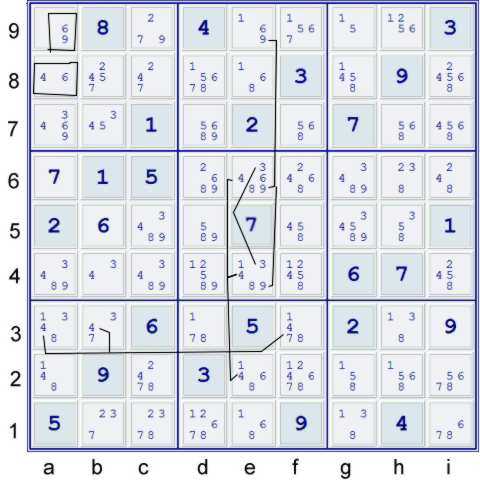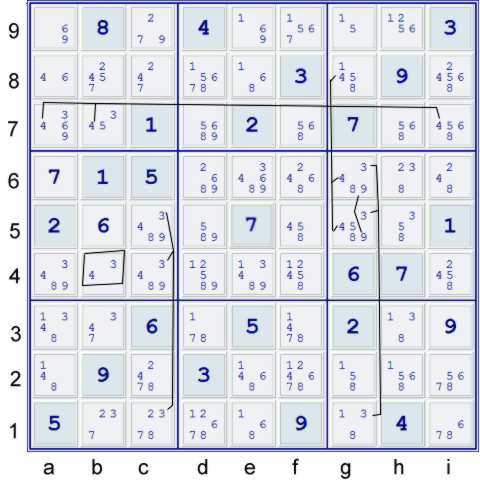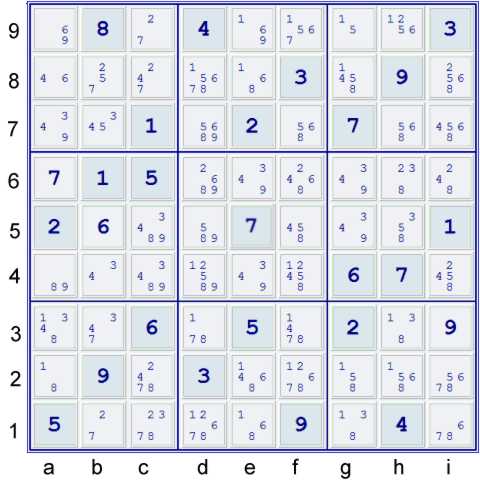The
Tough Sudoku of August 5, 2010 contains a reasonable teaching moment on how one
might find large continuous networks. A continouous network or continuous loop is perhaps one of the most powerful sudoku
technique, trick or tip. It certainly is my personal favorite type of sudoku deduction..
If this is your first visit to this blog, welcome! Unfortunately, if you are a first time visitor, this page may seem
like it is written in a different language. Well, it is!! Previous blog pages may be helpful. Links to these pages are
found to the right, under Sudoku Techniques. The earliest posts are at the bottom, and if you have never perused
the intricacies of our special coded language here, you may wish to start close to beginning. The list is rather large, so below
find a list of links that may be pertinent to this particular puzzle.
The Puzzle
Three UPs ( also called Unique Possibilities)are available here.
- Start 23
- (9)i3% row & box - hidden single in row 3 and also in box h2
- (7)i6% row & box
- (6)b5% box
- Thus, UP 26
Simple Sudoku can find no further deductions to make at this point. The puzzle in this state is shown below.
Puzzle where typical easy techniques are exhausted.

Here, I can find a relatively easy to locate, but rather long and complex continuous network. I find it by
using the following general form:
- Let CLA mean Continuous Loop A - a Boolean that is either true or false.
- Let CLB mean Continuous Loop B - again a Boolean
- Let A = CLA: In other words, at least one of A and CLA must exist
- Let B=CLB
- Let CLA-B: In other words, no more than one of B,CLA can be true
- Let CLB-A
- => CLA = A - CLB = B Loop, since B-CLA.
In such a case,
- All that CLA would eliminate is eliminated except for B.
- All that CLB would eliminate is eliminated except for A.
Informal Proof: There are many ways to prove this deduction. One can use induction, a proof by contradiction, or any of several other methods.
All of them boil down to this: CLA False cannot be caused by anything other than B True. If it is,
then CLA was not in fact a Continuous Loop. The logic may look circular. It is a valid circle, as we have proven the
larger Circle. Perhaps when I have time I may present a more formal proof.
Almost Continuous Loop A

Above, I have tried to highlight the SIS components of ACLA. One could write the following chain fragment:
- (4=6)a8 - (6=9)a9 - (9)e9 = HP(93)e46 - HP(34)e46 = (4)e2 - (4)f3 = (4)ab3
Almost Continuous Loop B

Above, I have tried to highlight the SIS components of ACLB. One could write the following chain fragment
- (4=3)b4 - (3)c45 = (3)c1 - (3)g1 = HP(39)g56 - HP(94)g56 = (4)g8 - (4)i7 = (4)ab7
Putting those two together, one has:
- Note that (4)af3 => Continuous Loop => (4)b3 = CLA
- Note that (4)ib7 => Continuous Loop => (4)a7 = CLB
- Note that (4)b3 is a target of CLB => (4)b3 - CLB
- Note that (4)a7 is a target of CLA => (4)a7 - CLA
- => CLA = (4)b3 - CLB = (4)a7 LOOP
- => the following 16 items can be eliminated:
- (4) from a24, b8, f2, i8
- (3) from a4,b1
- (9) from c9
- (6) from a7
- (68) from e6
- (18) from e4
- (58) from g5
- (8) from g6
A much easier Puzzle

From this point, Simple Sudoku Will finish the puzzle. One could say:
This method of combining chain fragments to find larger
continuous loops can be fruitful in finding large loops and large almost loops.
It is relatively easy to find such complex animals in this manner.
Post Log: If one is clever, one can add (3)row 3 to the deduction. If one reuses (34)b4, then to avoid an oddagon of length (3)
within the larger loop: CLA=A-CLB=B, one must in fact have A False, B False, CLA, CLB => All the original eliminations plus two more.
This implies that the puzzle will fall apart quickly using smaller (less native SIS) steps confined to those thirteen SIS.
The oddagon that one must avoid is a typical "short circuit" type oddagon that one must always avoid in continuous networks. Someday, I hope
to make that idea more formal. Suffice it to say that in this case:
- CLA = A - CLB = B Loop
- => CLA,A,CLB,B form an exactly one is true loop
- => a short cicuit of exactly one is true between, for example, CLA and CLB cannot occur
- CLB = (4-3)a7 = (3)b7 - (3=4)b4 - (4)b3 = CLA threatens to do just that
- => CLA - CLB cannot occur
- => CLA True, CLB True, (4)a7 False, (4)b3 False is the only escape